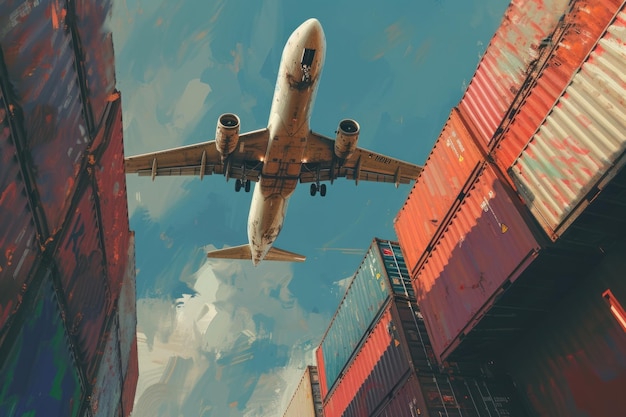Introduction

When it comes to shipping from China, businesses must decide between two main modes of transport: sea freight and air freight. Each option has its advantages and drawbacks, depending on the type of goods you’re transporting, delivery speed, and costs involved. In this article, we’ll delve into the key differences between sea freight and air freight, using our experience at UnionSource Global to help you determine which option best suits your needs.
Whether you’re just starting out in the export-import business or looking to optimize your logistics, understanding the pros and cons of both methods is essential for making an informed decision.
1. Speed of Delivery: Air Freight for Urgent Shipments

Air freight is the fastest shipping method, making it ideal for businesses that need products delivered quickly. If you have tight deadlines, such as a product launch or seasonal sales, air freight allows you to minimize wait times. Most air freight shipments arrive at their destination within 2-7 days, depending on the specific route and any customs delays.
Example: One of our clients at UnionSource Global, a European electronics retailer, needed a last-minute shipment of electronic components to meet customer demand during the holiday season. By using air freight, we ensured the products arrived within five days, avoiding lost sales and customer dissatisfaction.
However, the faster delivery comes at a higher cost, which brings us to our next point.
2. Cost Considerations: Sea Freight for Bulk Shipping

When it comes to cost, sea freight is the more economical option, particularly for large shipments. If you’re importing high volumes or bulky items, shipping by sea can save you a significant amount of money compared to air freight. The trade-off is longer shipping times, typically ranging from 20 to 45 days, depending on the destination.
Example: A U.S.-based furniture company working with UnionSource Global needed to import heavy, large pieces of furniture. The company chose sea freight, which offered a more cost-effective solution for shipping such bulky items. While the shipping time was longer, the savings were substantial, allowing the business to keep product costs competitive.
If your business model relies on high-volume orders and you can plan for longer lead times, sea freight is often the better choice.
3. Volume and Weight: How It Affects Freight Decisions
Air freight is typically charged by weight or volumetric weight (whichever is higher), while sea freight is priced based on container size (e.g., 20-foot or 40-foot containers). For smaller, lighter shipments, air freight can be cost-effective despite the higher per kilogram rate. However, for heavier, bulkier goods, sea freight is much more economical.
UnionSource Global often advises clients to calculate the total weight and volume of their goods to see which method offers the best value. For example, electronics and fashion accessories, which are lighter but high in value, may benefit from air freight, while machinery or raw materials are better suited for sea transport.
4. Flexibility in Cargo Types: What You Can Ship
Certain products may be restricted to specific shipping methods. Hazardous materials, perishable goods, or items with strict temperature control requirements often need to be shipped via air due to their sensitivity or regulatory restrictions. On the other hand, sea freight offers more flexibility for large, non-perishable goods and items that do not have urgent delivery timelines.
At UnionSource Global, we’ve worked with clients across various industries, from food and beverage to machinery. Understanding the nature of the cargo is critical in choosing the right method of shipping.
5. Environmental Impact: Sea Freight as the Greener Choice
For businesses concerned about their carbon footprint, sea freight is generally considered the more environmentally friendly option. Shipping by sea emits significantly fewer CO2 emissions compared to air freight, making it the greener choice for those looking to minimize environmental impact.
As sustainability becomes a growing concern for consumers and businesses alike, many companies are looking for ways to reduce their environmental impact throughout the supply chain. UnionSource Global helps clients consider both cost and sustainability when selecting their shipping methods.
6. Risk and Insurance: Navigating Potential Issues
Both air and sea freight come with inherent risks, but they differ in nature. Air freight is less prone to accidents or weather-related delays, but it is more expensive to insure. Sea freight, on the other hand, has a higher risk of delays due to port congestion or adverse weather conditions, and there is a risk of goods being damaged in transit, especially during loading and unloading.
At UnionSource Global, we advise clients to invest in comprehensive insurance coverage regardless of the shipping method. We also help manage risks by working with reputable freight forwarders and ensuring proper packaging and handling procedures.
7. Customs and Documentation: Compliance is Key
Both air and sea freight require careful attention to customs clearance and documentation. However, air freight tends to have faster customs processing, making it ideal for goods that need to clear borders quickly. Sea freight, due to the large volume of goods and longer shipping times, can sometimes face more extended customs delays.
UnionSource Global helps clients navigate these complexities by ensuring all necessary documentation is prepared in advance and by staying up to date with the latest customs regulations. Properly managed, both methods can deliver goods on time without unnecessary delays at customs.
Example: A company importing pharmaceuticals faced stringent customs requirements. Through our guidance at UnionSource Global, we ensured all necessary certifications were in place before shipment, allowing the goods to clear customs without delay.
Conclusion: Choosing the Right Shipping Method for Your Business
When deciding between air freight and sea freight, it’s essential to consider factors such as cost, speed, cargo type, and environmental impact. At UnionSource Global, we help businesses in the export-import industry make informed decisions about their logistics, ensuring their products arrive safely, on time, and within budget.
Both air and sea freight have their advantages, and the best option depends on your specific business needs. Whether you need fast delivery or cost-effective bulk shipping, UnionSource Global can guide you through the process, ensuring that your goods are shipped efficiently and reliably from China.



